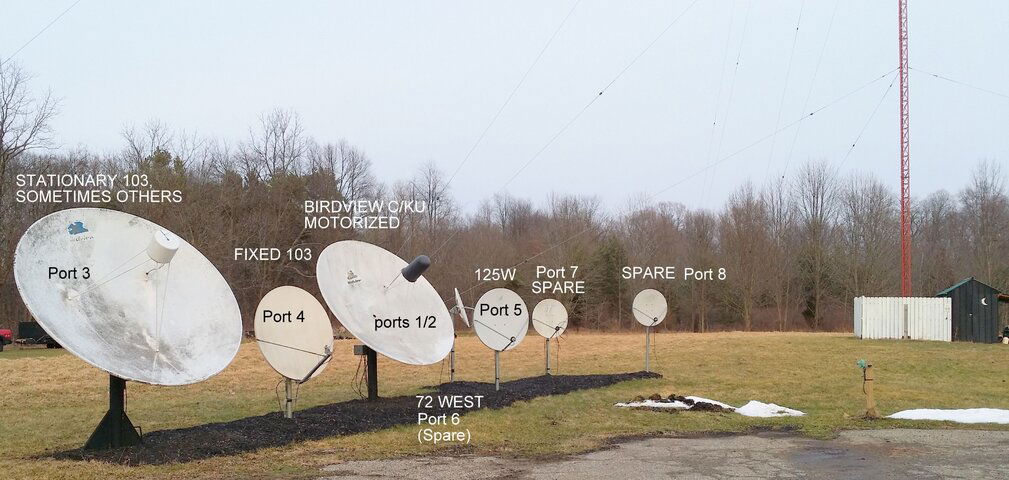Help me keep my sanity over 8-place diseqc feed and multiple dishes feeding single Amiko Mini receiver:
Setup at present:
port 1: C of C/Ku feed Birdview
port 2: Ku port of C/ku Birdview
port 3: Fixed Birdview on 103 C-band
port 4: Fixed Ku on 103
port 5: Fixed Ku on 125
Port 6: Spare: To be 97 ku, not used now
Port 7 Spare: To be fixed 99 C Band, (manual crank/6 footer) replaced Ku shown in picture.
Port 8: Spare: to be used for any Ku
I've followed the 101-C band thread on intermittent signal on retro and specialty networks. I have the same issue as everyone, But Me-TV locks fine. "normal" is how I'd describe it. (port 1)
Meanwhile, the FIXED 103 for Ion, PBS, etc with new feedline (which I thought was a problem) acts like T-I ( iClosest analogy I can give) is causing it to dip signal regularly, but unpredictably. (port 3)
Thought I'd swap-in the MicroHD in for the Amiko. Just the reverse happened. After proper port settings were input to the MicroHD, my 103 on the fixed dish port 3 for Ion became steady, and the 101 feed port 1/motorized dish couldn't even show a 45 percent "yes, you have LNB" noise signal! All other fixed dishes feeding BOTH receivers worked fine. I even rotated through all the transponders shown to see if ANY would make the signal meter respond. Nope. I'm hoping that rules out loss of a polarity voltage.
It seems like on the Amiko setup that the 103 and 101 are interfering with each other... and one receiver reads the issue differently than the other! The Amiko seems to impress the bouncing signal issue of 101 onto the fixed 103....meanwhile the MicroHD recognizes a strong 103 on the fixed dish with no problems at all, but 101 does not exist!
I've not changed any wires, I've verified my motorized dish port 1 C-band LNB is okay, rotating to 95, 99, 101, and 103.
Why in the world will two different receivers have completely opposite symptoms? One gets 101's Me-TV steadily with the usual signal dropouts & the same issues were all having on the others, and that same receiver has signal dips on 103's ION from my fixed dish, while the other receiver sees NO Me-TV (not even the LNB) but gets a steady and strong signal and lock on all the 103 Ion and other transponders?
In this hobby, about the time you think you understand enough to handle anything, you're knocked back down the ladder and asking your Satellitguys friends for advice! Is it possible I have T-I that is more noticeable on certain receivers than others and on different transponder frequencies? Hopefully it's something ELSE...
Hopefully I've put this logically enough to follow...
So, I'm asking....what in the WORLD is going on?

Setup at present:
port 1: C of C/Ku feed Birdview
port 2: Ku port of C/ku Birdview
port 3: Fixed Birdview on 103 C-band
port 4: Fixed Ku on 103
port 5: Fixed Ku on 125
Port 6: Spare: To be 97 ku, not used now
Port 7 Spare: To be fixed 99 C Band, (manual crank/6 footer) replaced Ku shown in picture.
Port 8: Spare: to be used for any Ku
I've followed the 101-C band thread on intermittent signal on retro and specialty networks. I have the same issue as everyone, But Me-TV locks fine. "normal" is how I'd describe it. (port 1)
Meanwhile, the FIXED 103 for Ion, PBS, etc with new feedline (which I thought was a problem) acts like T-I ( iClosest analogy I can give) is causing it to dip signal regularly, but unpredictably. (port 3)
Thought I'd swap-in the MicroHD in for the Amiko. Just the reverse happened. After proper port settings were input to the MicroHD, my 103 on the fixed dish port 3 for Ion became steady, and the 101 feed port 1/motorized dish couldn't even show a 45 percent "yes, you have LNB" noise signal! All other fixed dishes feeding BOTH receivers worked fine. I even rotated through all the transponders shown to see if ANY would make the signal meter respond. Nope. I'm hoping that rules out loss of a polarity voltage.
It seems like on the Amiko setup that the 103 and 101 are interfering with each other... and one receiver reads the issue differently than the other! The Amiko seems to impress the bouncing signal issue of 101 onto the fixed 103....meanwhile the MicroHD recognizes a strong 103 on the fixed dish with no problems at all, but 101 does not exist!
I've not changed any wires, I've verified my motorized dish port 1 C-band LNB is okay, rotating to 95, 99, 101, and 103.
Why in the world will two different receivers have completely opposite symptoms? One gets 101's Me-TV steadily with the usual signal dropouts & the same issues were all having on the others, and that same receiver has signal dips on 103's ION from my fixed dish, while the other receiver sees NO Me-TV (not even the LNB) but gets a steady and strong signal and lock on all the 103 Ion and other transponders?
In this hobby, about the time you think you understand enough to handle anything, you're knocked back down the ladder and asking your Satellitguys friends for advice! Is it possible I have T-I that is more noticeable on certain receivers than others and on different transponder frequencies? Hopefully it's something ELSE...
Hopefully I've put this logically enough to follow...
So, I'm asking....what in the WORLD is going on?


